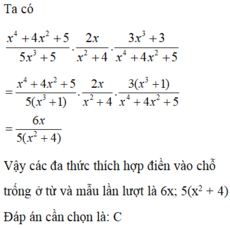Hãy nhập câu hỏi của bạn vào đây, nếu là tài khoản VIP, bạn sẽ được ưu tiên trả lời.

a: \(A\left(x\right)=2x^4-x^3+3x^2+9x-2\)
\(B\left(x\right)=2x^4-5x^3-x+9\)
\(C\left(x\right)=x^4+4x^2+5\)
A(x): bậc 4; hệ số cao nhất là 2; hệ số tự do là -2
B(x): bậc 4; hệ số cao nhất là 4; hệ số tự do là 9
b: M(x)=A(x)+B(x)=4x^4-6x^3+3x^2+8x+7
N(x)=B(x)-A(x)=-4x^3-3x^2-10x+11
c: Q(x)=-N(x)=4x^3+3x^2+10x-11

a) \(x^3+4x^2-29x+24=x^3-x^2+5x^2-5x-24x+24\)
\(=x^2\left(x-1\right)+5x\left(x-1\right)-24\left(x-1\right)\)
\(=\left(x-1\right)\left(x^2+5x-24\right)\)
\(=\left(x-1\right)\left(x^2+8x-3x-24\right)\)
\(=\left(x-1\right)\left[x\left(x+8\right)-3\left(x+8\right)\right]\)
\(=\left(x-1\right)\left(x+8\right)\left(x-3\right)\)
b) \(x^4+6x^3+7x^2-6x+1\)
\(=x^4+\left(6x^3-2x^2\right)+\left(9x^2-6x+1\right)\)
\(=x^4+2x^2\left(3x-1\right)+\left(3x-1\right)^2\)
\(=\left(x^2+3x-1\right)^2\)
c) \(\left(x^2-x+2\right)^2+\left(x-2\right)^2=x^4-2x^3+6x^2-8x+8\)
\(=\left(x^4-2x^3+2x^2\right)+\left(4x^2-8x+8\right)\)
\(=x^2\left(x^2-2x+2\right)+4\left(x^2-2x+2\right)\)
\(=\left(x^2-2x+2\right)\left(x^2+4\right)\)
d) Phức tạp mà dài quá :v
\(6x^5+15x^4+20x^3+15x^2+6x+1\)
\(=6x^5+3x^4+12x^4+6x^3+14x^3+7x^2+8x^2+4x+2x+1\)
\(=3x^4\left(2x+1\right)+6x^3\left(2x+1\right)+7x^2\left(2x+1\right)+4x\left(2x+1\right)+\left(2x+1\right)\)
\(=\left(2x+1\right)\left(3x^4+6x^3+7x^2+4x+1\right)\)
\(=\left(2x+1\right)\left[\left(3x^4+3x^3+x^2\right)+\left(3x^3+3x^2+x\right)+\left(3x^2+3x+1\right)\right]\)
\(=\left(2x+1\right)\left[x^2\left(3x^2+3x+1\right)+x\left(3x^2+3x+1\right)+\left(3x^2+3x+1\right)\right]\)
\(=\left(2x+1\right)\left(3x^2+3x+1\right)\left(x^2+x+1\right)\)
e)
- Câu này có thể áp dụng định lý: nếu tổng các hệ số biến bậc chẵn và tổng các hệ số biến bậc lẻ bằng nhau thì đa thức có nhân tử x + 1.
- Nhận thấy: 1 + 4 + 4 + 1 = 3 + 4 + 3
\(x^6+3x^5+4x^4+4x^3+4x^2+3x+1\)
\(=(x^6+x^5)+(2x^5+2x^4)+(2x^4+2x^3)+(2x^3+2x^2)+(2x^2+2x)+(x+1)\)
\(=x^5(x+1)+2x^4(x+1)+2x^3(x+1)+2x^2(x+1)+2x(x+1)+(x+1)\)
\(=(x+1)(x^5+2x^4+2x^3+2x^2+2x+1)\)
Tiếp tục phân tích bằng cách trên vì 1 + 2 + 2 = 2 + 2 +1
\(=\left(x+1\right)\left(x+1\right)\left(x^4+x^3+x^2+x+1\right)\)
\(=\left(x+1\right)^2\left(x^4+x^3+x^2+x+1\right)\)
a) Gọi CT ghi hóa trị của NH3 là \(N^xH^I_3\) (x: nguyên, dương)
Theo quy tắc hóa trị, ta có:
\(x.1=I.3\\ =>x=\dfrac{1.I}{3}=III\)
Vậy: Hóa trị của N có hóa trị III trong hợp chất NH3
b) Gọi CT kèm hóa trị của Zn(OH)2 là \(Zn^x\left(OH\right)^y_2\) (x,y: nguyên, dương).
Theo quy tắc hóa trị, ta có:
\(x.1=y.2\\ =>\dfrac{x}{y}=\dfrac{2}{1}=\dfrac{II}{I}\)
=> x=II
y=I
=> Hóa trị của Zn là II trong hợp chất trên

a) \(x^2+4x+4=\left(x+2\right)^2\)
b) \(x^2-8x+16=\left(x-4\right)^2\)
c) \(\left(x+5\right)\left(x-5\right)=x^2-25\)
g) \(\left(x-2\right)\left(x^2-2x+4\right)\)
\(=x^3-8\)

Bài 1:
a: \(x^3-6x^2+11x-6\)
\(=x^3-x^2-5x^2+5x+6x-6\)
\(=\left(x-1\right)\left(x^2-5x+6\right)\)
\(=\left(x-1\right)\left(x-2\right)\left(x-3\right)\)
b: \(x^3-6x^2-9x+14\)
\(=x^3-7x^2+x^2-7x-2x+14\)
\(=\left(x-7\right)\left(x^2+x-2\right)\)
\(=\left(x-7\right)\left(x+2\right)\left(x-1\right)\)
c: \(x^3+6x^2+11x+6\)
\(=x^3+3x^2+3x^2+9x+2x+6\)
\(=\left(x+3\right)\left(x^2+3x+2\right)\)
\(=\left(x+3\right)\left(x+1\right)\left(x+2\right)\)

a) \(4x\left(a-b\right)+6xy\left(b-a\right)\)
\(=4x\left(a-b\right)-6xy\left(a-b\right)\)
\(=\left(4x-6xy\right)\left(a-b\right)\)
\(=2x\left(2-3y\right)\left(a-b\right)\)

a: \(N=\dfrac{3x^5-4x^4+6x^3}{-2x^2}=-\dfrac{3}{2}x^3+2x^2-3x\)
b: \(N=\dfrac{\left(6x^4y^5-3x^3y^4+\dfrac{1}{2}x^4y^3z\right)}{-\dfrac{1}{3}x^2y^3}=-18x^2y^2+9xy-\dfrac{3}{2}x^2z\)
c: \(\Leftrightarrow N\cdot\left(y-x\right)=\left(x-y\right)^3\)
\(\Leftrightarrow N=\dfrac{\left(x-y\right)^3}{y-x}=-\left(y-x\right)^2\)
d: \(\Leftrightarrow N\cdot\left(y^2-x^2\right)=\left(y^2-x^2\right)^2\)
hay \(N=y^2-x^2\)

a/
\(=x^4-x^3-x^2+3x+\left(2x^3-2x^2-2x+6\right)\)
\(=x\left(x^3-x^2-x+3\right)+2\left(x^3-x^2-x+3\right)\)
\(=\left(x+2\right)\left(x^3-x^2-x+3\right)\)
b/
\(=x^4+x^3+5x^2+\left(x^2+x+5\right)\)
\(=x^2\left(x^2+x+5\right)+\left(x^2+x+5\right)\)
\(=\left(x^2+1\right)\left(x^2+x+5\right)\)
c giống b
d/ \(=x^4-2x^3+7x^2+\left(x^3-2x^2+7x\right)+\left(2x^2-4x+14\right)\)
\(=x^2\left(x^2-2x+7\right)+x\left(x^2-2x+7\right)+2\left(x^2-2x+7\right)\)
\(=\left(x^2+x+2\right)\left(x^2-2x+7\right)\)
